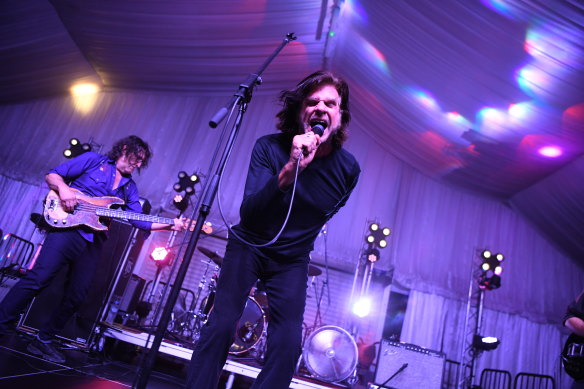
“We’ve been going for over three and a half years now full-time, and we need to keep going,” Van Mil said. “It’s a vital, vital service … and the fundraising environment is harder and harder. It’s tough.”
The publicly available accounts show the parent organisation spent about $215,000 on marketing. Van Mil said this included staff costs and the hard costs of professional photography and videography, which were essentially the cost of fundraising.

Tex Perkins with The Cruel Sea performing at a fundraising concert for the Byron Bay Wildlife Hospital, 2023.Credit: James D Morgan
The initial set-up was paid for by a crowdfunding campaign that yielded about $500,000 after the 2019–2020 Black Summer bushfires. Last year, Tex Perkins and his band, the Cruel Sea, led a fundraising concert at the Bluesfest venue, earning over $100,000 for the hospital.
WIRES, which raised $70 million after the Black Summer fires, declined to fund the Byron Bay Wildlife Hospital, though the organisations have collaborated on some projects.
The former NSW government announced $1.5 million in ongoing funding shortly before the 2023 election but did not budget the money. It later turned out to be conditional on the organisation winning a grant for which it was ineligible.
More recently, the hospital won a $110,000 state government grant, while other wildlife rescue organisations, such as a nearby koala hospital, were also given funding. Van Mil said this money was for a community education project and could not be used for ongoing operations.
‘Hugely devastating’
Southern Cross University vice chancellor Tyrone Carlin said the university was setting up Australia’s eighth veterinary school at its Lismore campus. The school will focus on wildlife care through a partnership with the Byron Bay Wildlife Hospital.
Carlin said the volume and quality of the work and the hospital’s setup were exceptional, and it would be “hugely devastating” if it had to close.
Loading
“The vision and the passion, the ambition is really world-class … and we’re massive admirers of that work,” Carlin said.
Wildlife Recovery Australia is chaired by economist Dr Ken Henry, who was the lead reviewer of the NSW Biodiversity Act. His recommendations last year included considering funding accredited wildlife hospitals and reimbursing private veterinary practices for the cost of treating injured wildlife.
In May, the NSW government launched a statewide consultation on the wildlife rehabilitation sector, with a report due in 12 months. Government figures suggest that 40 wildlife rehabilitation groups involving more than 8600 people rescue an average of 110,000 animals a year across the state.
Taronga chief executive Cameron Kerr and another executive from the zoo met Van Mil and Talbot in April. Kerr said he appreciated the briefing, and the zoo took a collaborative approach to working with industry partners at all levels.









 Add Category
Add Category